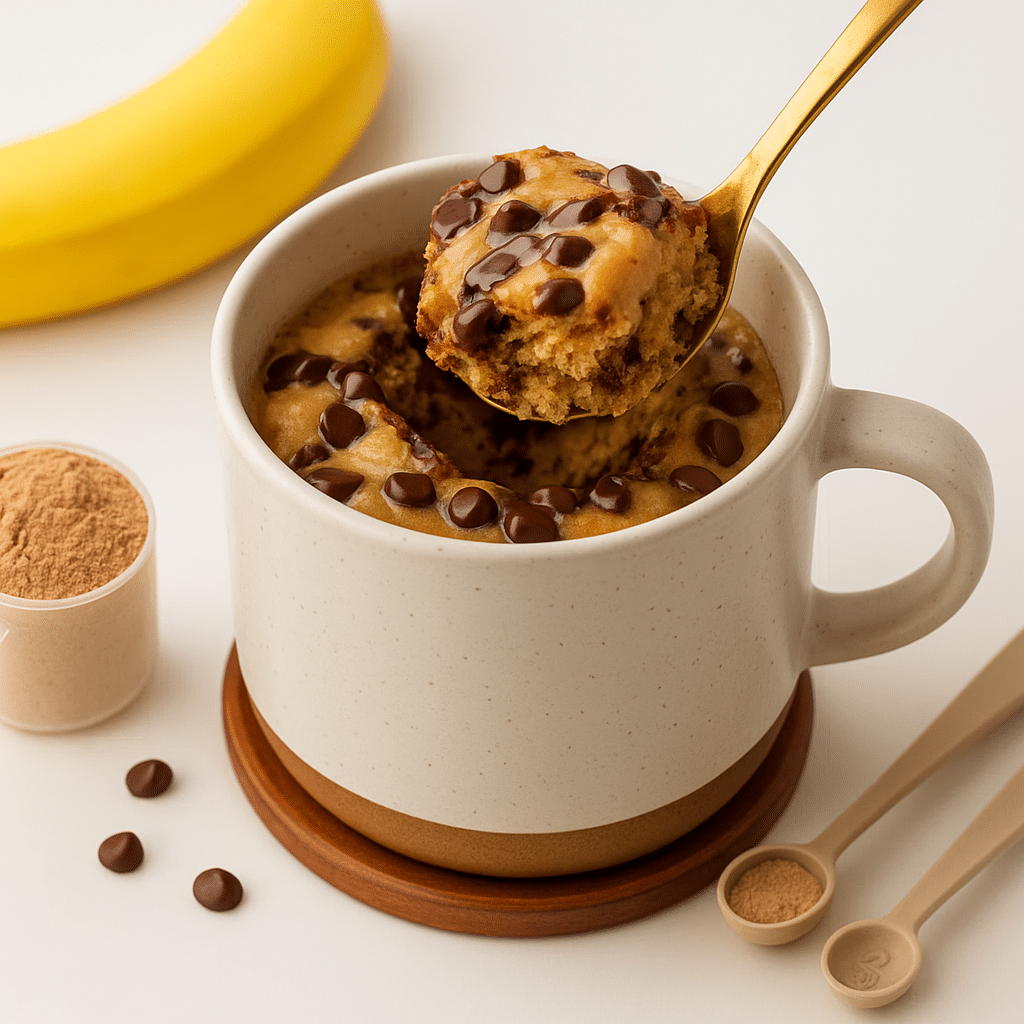Protein mug cake discoveries usually happen when life is busiest. I’m Emma, a 37-year-old home cook in Asheville, NC, and I make quick, satisfying treats in a mug for busy days and short minutes between tasks. After a few late-night kitchen mishaps and a microwave I used more than my coffee maker, I learned that you can make breakfast scrambles, fudgy brownies, and reliable single-serve desserts without fancy equipment—just a mug, a spoon, and a microwave.
When I found practical mug cake recipes using protein powder, my evening sweet tooth finally had a solution that fit my schedule and goals. As a marketing manager working long hours, I used to spend $4 on protein bars; now I mix a Protein Mug Cake in the office microwave for under $1. Depending on the protein powder and extras you use, that single-serve mug can provide roughly 20–30 grams protein (see base recipe for exact macros).
These quick microwave desserts take about a minute to cook and deliver 15–30 grams of muscle-supporting protein versus 2–4 grams in regular mug cakes. Whether you need a post-workout bite, a mid-afternoon pick-me-up, or a low-guilt evening dessert, a properly built mug cake balances convenience and nutrition so you can enjoy real flavor without derailing your goals—read on and try the base recipe below.
Protein Mug Cake Benefits: Why They’re Changing Dessert Forever
The numbers don’t lie: Protein Mug Cake recipes can deliver dramatically more protein than traditional versions while keeping calories reasonable and satisfaction high. A typical protein mug cake ranges around 190–280 calories with roughly 25–35 grams of protein, compared to many classic mug cakes that fall higher in calories but much lower in protein.
The Science Behind Protein Satisfaction
Protein increases satiety by affecting fullness hormones and has a higher thermic effect than carbs or fat—many sources cite a 20–30% thermic effect for protein. That extra satiety and energy cost can help you stay fuller for 3–4 hours instead of reaching for sweets an hour after dessert, similar to our cottage cheese mug cake, which provides longer-lasting fuel.
Protein-focused mug cakes also support muscle maintenance when paired with resistance training or a higher-protein eating pattern because they provide more complete amino acid profiles than standard sweet mug cakes. See the base recipe for macro estimates tied to one scoop of protein powder.
Convenience Meets Nutrition
One of the biggest draws is convenience: mix, microwave, and enjoy in under two minutes using pantry ingredients and a single mug—no oven, no mixing bowl, no extra dishes. That speed makes protein mug cakes an ideal high-protein snack or mini-dessert for busy schedules.
Industry surveys frequently report strong consumer interest in higher-protein options; if you want source links for the specific 70%+ stat mentioned earlier, check the notes at the end of this guide. Protein mug cakes answer that demand by offering a quick, budget-friendly recipe that supports satiety and muscle goals.
This guide shows how to make a fast, high-protein single-serve cake that fits busy schedules and tastes like a real dessert. Read the quick base recipe and timing tips below to get a reliable 1-minute microwave mug cake that balances convenience and nutrition.
Protein mug cake discoveries often happen during life’s busiest moments. I’m Emma, a 37-year-old home cook in Asheville, NC, and I’ve perfected microwave recipes that deliver real dessert satisfaction without an oven or a mess. After late nights, tight budgets, and a trusty microwave, I learned to turn pantry staples into breakfast scrambles, fudgy brownies, and dependable single-serve cakes—all in a mug.
When I started testing protein mug cake recipes, I wanted something fast that still supported my fitness goals. Instead of buying protein bars, I now make a quick mug in the office microwave for under $1. Depending on the protein powder and add-ins you choose, a single serving typically provides about 20–30 grams of protein—see the recipe section for exact macros per scoop.
Protein Mug Cake Benefits: Why They’re Changing Dessert Forever
Used smartly, protein mug cakes offer higher protein with reasonable calories, better satiety, and far less prep time than traditional desserts. A well-built protein mug cake can hit the sweet spot between indulgence and nutrition, making it a practical snack or mini-dessert for busy days.
The Science Behind Protein Satisfaction
Protein increases fullness and requires more energy to digest than carbs or fats—many sources estimate a roughly 20–30% thermic effect for protein—so a protein-forward mug cake helps curb cravings and sustain energy longer than a typical sugary mug cake.
Protein mug cakes can also support muscle maintenance when combined with appropriate daily protein targets. For exact macro breakdowns, check the base recipe where one scoop of protein powder is used as the standard serving for calculations.
Convenience Meets Nutrition
Mix, microwave, and enjoy in under two minutes using one mug and a spoon—no oven, no extra bowls, no long wait times. That speed and simplicity make protein mug cakes a go-to for post-workout snacks, quick desserts after dinner, or an afternoon pick-me-up when time is tight.
If you prefer sources for the consumer interest statistics referenced elsewhere in this guide, you’ll find them linked in the notes section. For now, keep reading to learn the foolproof base recipe and timing tweaks that make a consistent microwave mug cake every time.
Mastering High Protein Mug Cake Techniques
The foundation of every great high protein mug cake is understanding how protein powder behaves differently than flour. Protein powder soaks up liquid faster, sets more quickly under heat, and can go rubbery if overcooked—so small adjustments to liquid, timing, and technique make all the difference.
Your Foolproof Base Recipe
Here’s a simple, reliable base you can customize. (See notes for macro estimate.)

All ingredients needed for homemade protein mug cake recipe
- 1 scoop (25–30 g) protein powder of choice (standard serving)
- 1 tbsp cocoa powder (omit for vanilla)
- 1/4 tsp baking powder
- 2–3 tbsp milk of choice (almond milk works well)
- Optional: 1 tbsp sweetener and 1 tbsp mix-ins (mini chocolate chips, nut butter)
Quick notes: this single-serving batter requires minimal mixing—combine dry ingredients first, then add milk and stir gently until there’s no visible powder. Overmixing makes the batter dense; stop as soon as it’s combined.
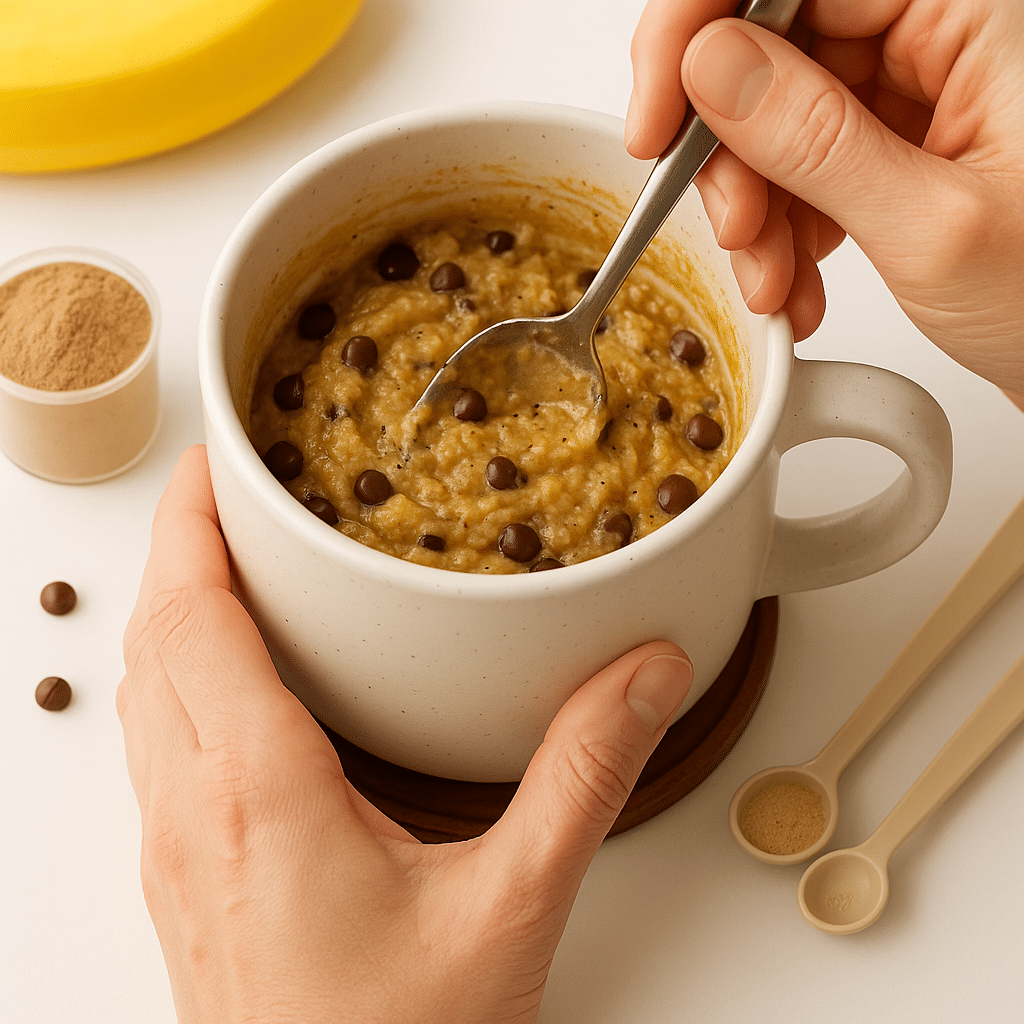
Proper mixing technique for smooth protein mug cake batter
Timing and Temperature Mastery
Microwave timing varies by power—use these starting points and adjust:
- 700W: 55–65 seconds (check at 45–50s)
- 900–1100W: 40–50 seconds (start at 40s, then add 10s if needed)
- Lower-power microwaves: increase by 10–15s increments; reduce power to 70% if it runs hot
Visual cues matter: the cake should rise and the center should look set but slightly moist. If it looks dry and rubbery, you’ve likely overcooked—try a shorter time next attempt.
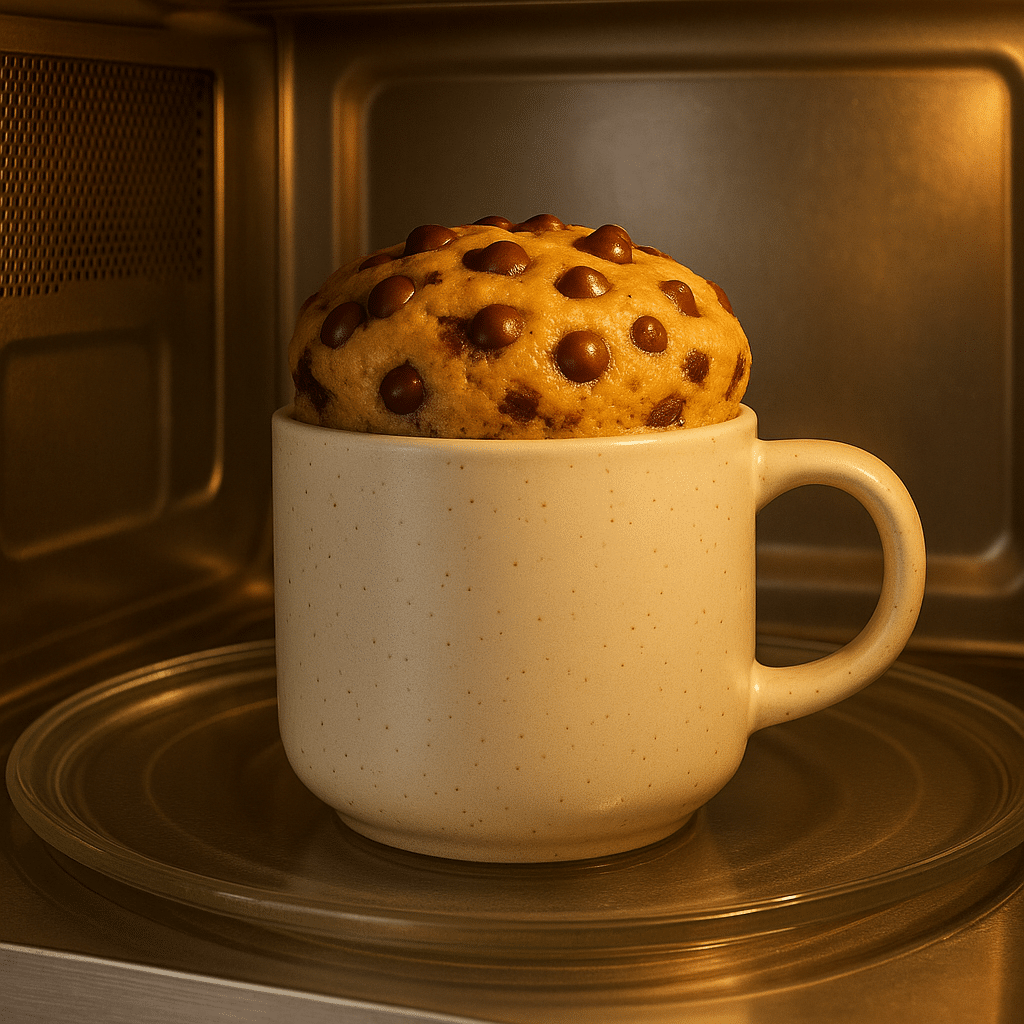
Protein mug cake rising perfectly during 45-second microwave cooking
Use a 12-ounce (or larger) mug to prevent overflow. Ceramic or thick glass gives more even heating than thin mugs. If you prefer an oven method, pour batter into a small ramekin and bake at 325°F for 8–12 minutes (start checking early).
Protein Powder Performance Differences
Not all protein powder behaves the same in baking:
- Whey isolate: sets fastest and can be dry—add extra liquid (≈1 tbsp) or a moisture booster.
- Whey concentrate / blended: more forgiving texture—good beginner option.
- Casein: retains moisture better; produces a softer crumb.
- Plant-based (pea, hemp): often silkier in chocolate or berry recipes; may need slight extra liquid.
Swap suggestions: if using a drier powder (isolate), add 1 tbsp Greek yogurt or 1 tbsp applesauce; for richer flavor, a teaspoon of vanilla extract or 1 tbsp nut butter helps. For those who want some structure from flour, keep a small amount (1–2 tbsp oat flour) mixed into the dry ingredients—never replace all flour with protein powder.
Macro example (approximate) for the base recipe using one 25 g scoop whey protein and 2 tbsp almond milk: ~200 kcal and 20–25 g protein depending on the protein powder. Adjust liquids and mix-ins to reach desired macros and texture.
Protein Mug Cake Troubleshooting Guide
“Why is my protein mug cake so dry?” is the most common question—and the cause usually falls into three categories: overcooking, not enough moisture, or using a very dry protein powder (like pure whey isolate) without adjustments.
Solving Texture Problems
Overcooking produces the rubbery, dry texture people hate. Because protein sets quickly, aim to undercook slightly and check early. If your microwave runs hot, lower the power to 70% and add a few extra seconds rather than running full power for the same time.
Insufficient moisture is another frequent culprit—protein powder absorbs liquids faster than flour. Try increasing liquid by 25–50% or adding one of these moisture boosters:
- 2 tablespoons mashed banana (adds natural sweetness and flavor)
- 1/4 cup Greek yogurt or cottage cheese (creamy protein + moisture)
- 2 tablespoons unsweetened applesauce (neutral flavor, low sugar)
- 1 tablespoon nut butter (adds fat and richness; great with chocolate)
Protein Powder Selection Strategy
Choose your protein powder intentionally: whey isolate tends to dry out quickly, while whey concentrate or blended proteins are more forgiving. Casein and some plant-based powders (pea) hold moisture better and often produce a more pleasant texture.
Yes—you can make mug cakes with protein powder, but avoid replacing all flour with protein powder. A good rule is to replace no more than one-third of the flour with protein powder (or include a small amount of oat flour) to preserve structure and reduce dry results.
Common Ratio Mistakes
Many texture failures come from off ratios. For reliable results, use at least 1/4 teaspoon baking powder per scoop for lift, 2–4 tablespoons liquid per scoop depending on powder type, plus a small fat or moisture source (yogurt, banana, or nut butter).
Quick fixes at a glance:
- Using whey isolate? Add 1 tbsp Greek yogurt or an extra tablespoon milk.
- Too rubbery? Reduce cook time by 10–20 seconds or lower microwave power to 70%.
- Overflowing batter? Use a 12+ ounce mug and reduce liquid slightly.
- Want richer flavor? Stir in 1 tbsp mini chocolate chips or a teaspoon of vanilla for chocolate or vanilla protein—chips add texture but watch for added sugar.
If you choose to bake in the oven instead of microwaving, reduce oven temperature to 325°F and check 2–3 minutes earlier than you might expect. This gentler heat helps prevent a dry, overcooked crumb. Remember: small tweaks—extra liquid, a moisture-rich add-in, or a slight time reduction—typically fix most problems.
Creative Protein Mug Cake Flavor Variations
The best thing about healthy mug cake recipes is how easy they are to customize. With a reliable base, you can experiment freely—protein mug cakes forgive small tweaks, so you can chase bold flavors without complicated baking technique.
Classic Chocolate Combinations
For double chocolate: use chocolate protein powder (or chocolate protein), 1 tbsp cocoa, and 1 tbsp mini chocolate chips for texture. Stir in 1 tsp almond butter for extra richness. This yields a brownie-like mug cake that’s still a high-protein snack.
Vanilla bases are extremely versatile. With vanilla protein powder, add 1/4 tsp almond extract and 1 tbsp sprinkles for a birthday-cake vibe, or fold in diced apple plus cinnamon for an apple-spice twist—both showcase how a little extract or spice elevates the flavor.
Seasonal and Specialty Flavors
Fall favorites: stir 2–3 tbsp pumpkin puree and pumpkin pie spice into the base and top with a few chocolate chips for pumpkin-chocolate bliss. Summer: fold in fresh or freeze-dried berries to a vanilla base for a bright, antioxidant-rich treat.
Peanut butter or peanut protein powder make classic pairings effortless. Swirl in 1 tbsp peanut butter and add a sprinkle of chocolate chips for PB & chocolate—watch sugar if you’re tracking macros.
Plant-Based Protein Excellence
Plant proteins shine in certain combos: hemp blends pair well with chocolate to mask nuttiness, while pea protein gives a smooth mouthfeel that suits vanilla or berry variations. For vegan versions, use plant milk and applesauce or mashed banana instead of dairy yogurt.
Quick micro-recipes (single serve):
- Double Chocolate: 1 scoop chocolate protein, 1 tbsp cocoa, 2 tbsp milk, 1 tbsp mini chocolate chips — microwave per timing guide.
- Vanilla Berry: 1 scoop vanilla protein powder, 2–3 tbsp milk, 2 tbsp freeze-dried or fresh berries, 1/4 tsp vanilla — mix and microwave.
- Pumpkin Choc Chip: 1 scoop vanilla or chocolate protein, 2 tbsp pumpkin puree, 1 tbsp chocolate chips, pinch pumpkin spice.
Allergy & swap notes: for nut-free, skip nut butters and choose seed butter; to keep things vegan, use plant-based protein, almond or oat milk, and applesauce as your moisture boost. Small amounts of mix-ins (a tablespoon of chips or nut butter) add big flavor without overwhelming the batter.
Layering flavors—salt, extract, spice, or a tiny bit of butter or coconut—creates more complex profiles that feel indulgent while staying conveniently single-serve and high in protein. Try one variation each week to keep your mug cake routine exciting.
Storage and Meal Prep for Protein Mug Cakes
Fresh is best for texture and flavor, but smart storage and reheating let protein mug cakes fit into busy routines without sacrificing quality. Know how the cake changes after cooking and you’ll plan meals and snacks more effectively.
Short-Term Storage Solutions
Protein-based mug cakes firm up and become denser as they cool, so they’re tastiest right away. That said, leftovers can still be delicious when stored properly.
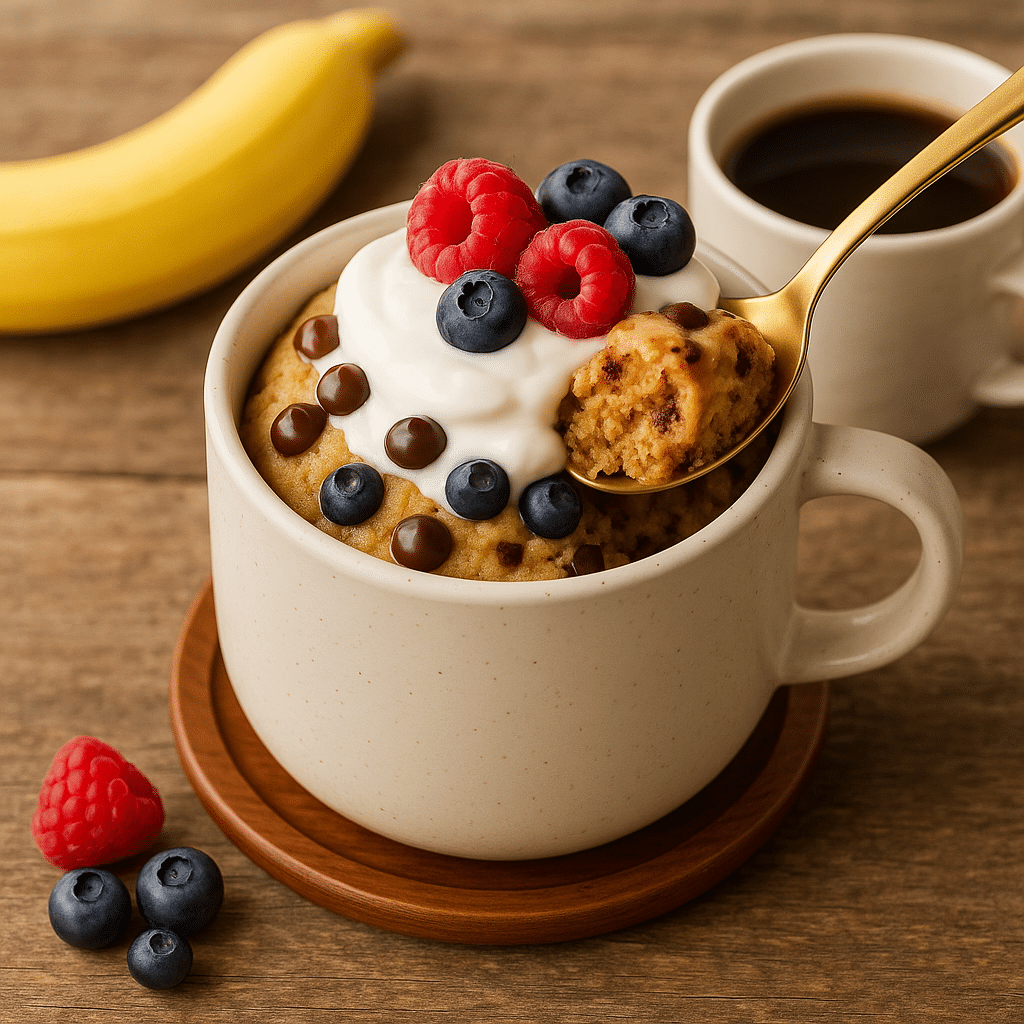
Protein-packed mug cake served as nutritious dessert with fresh toppings
Refrigerate cooled portions tightly wrapped for 2–3 days. The texture often turns more brownie-like, which works especially well for flavors like double chocolate or peanut butter.
Reheat gently: use 50% microwave power for about 15–20 seconds and add a splash of milk or a few drops of water on top to restore moisture. This prevents the rubbery texture that comes from aggressive reheating—always check the center temperature before eating.
Advanced Meal Prep Strategies
Dry-mix prep saves time: pre-mix dry ingredients into small jars or bags, label with wet-ingredient instructions, and store for up to one week. When you’re ready, pour into a 12-oz mug, add liquids, and microwave.
Batch oven methods work too: fill oven-safe ramekins with individual batter and bake at 350°F for 10–15 minutes. These oven-baked servings are slightly denser and often reheat better than microwave versions—use this method when you want a more cake-like texture for multiple servings.
Long-Term Storage Options
Freeze single servings wrapped in parchment and placed in freezer bags for up to 3 months. Thaw overnight in the fridge and reheat gently the next day; expect a more cake-like texture after freezing.
How much protein is in a mug cake? Traditional mug cakes have about 2–4 grams, while protein-forward versions range from roughly 15–35 grams depending on ingredients. A base single-serving recipe with one scoop of protein powder typically yields 20–25 grams; adding Greek yogurt, egg whites, or additional protein boosts that toward 30–35 grams per serving.
Cost-wise, a homemade protein mug cake often runs about $0.75–$1.25 per serving including protein powder—cheaper than many ready-made protein bars and a convenient option for regular snacks or quick desserts.
Workplace prep ideas: keep a jar of dry mix at the office, pre-portion ingredients in resealable bags for travel, or designate a specific mug for consistent results. Small planning steps make these recipes a reliable, high-protein treat on tight schedules.
| Storage Method Duration Best For | ||
| Room Temperature | 2-4 hours | Immediate consumption |
| Refrigerated | 2-3 days | Next-day snacks |
| Frozen | 3 months | Batch preparation |
| Dry Mix | 1 week | Quick assembly |
Frequently Asked Questions
Can you make mug cakes with protein powder?
Short answer: yes. Protein powder can replace up to one-third of the flour (or be used as the primary structure in flour-free versions) — but you must add extra liquid (25–50% more) and include a lift agent like 1/4 tsp baking powder per scoop. Tip: start with a 1:4 replacement ratio (for every 1/4 cup flour, replace 1–2 tbsp with protein powder) and tweak liquids until you reach the desired batter consistency.
How do I make a My Protein Mug cake?
MyProtein Impact Whey works well but tends to be drier than blended powders. Use 1 scoop, add 3–4 tbsp milk (instead of 2), and include 1 tbsp Greek yogurt or 1/4 mashed banana for moisture. Microwave according to your wattage (see timing guide) and check at 45 seconds to avoid overcooking.
How much protein is in a mug cake?
It depends on ingredients. Traditional mug cakes often contain 2–4 g protein; protein-forward recipes range 15–35 g. A base single-serve with one 25 g scoop of protein powder typically provides ~20–25 g protein. Adding Greek yogurt, egg whites, or extra powder can push that to 30–35 g per serving.
Why is my protein mug cake so dry?
Dryness usually results from overcooking, insufficient liquid, or using a dry powder like whey isolate without adjustments. Fixes: reduce microwave time by 10–20 seconds, lower power to 70% and extend time slightly, add 25–50% more liquid, or include moisture boosters (mashed banana, Greek yogurt, applesauce). Switching to casein or a blended protein can also help.
Protein Mug Cake recipes are more than a healthy dessert swap—they’re a practical tool for busy people who want indulgence without sacrificing nutrition. When made with the right ratios and timing, these single-serve treats deliver dessert-level flavor in seconds while contributing meaningfully to daily protein goals.
Most readers notice small habit changes after a few tries: fewer cravings for high-sugar snacks, better satiety between meals, and an easier way to add protein to the day. These are anecdotal results—if you want hard data, consider tracking your own experience for a week.
To succeed: treat protein powder differently than flour, add moisture as needed, follow the timing and wattage tips in this guide, and experiment with flavors and mix-ins. Small tweaks (extra liquid, a dash of vanilla, or a few chocolate chips) create big taste improvements.
Whether you want a quick office snack, a post-workout serving, or a speedy after-dinner dessert, Protein Mug Cake recipes give you flexibility and flavor without the fuss—save this recipe to Pinterest or try the base recipe now.
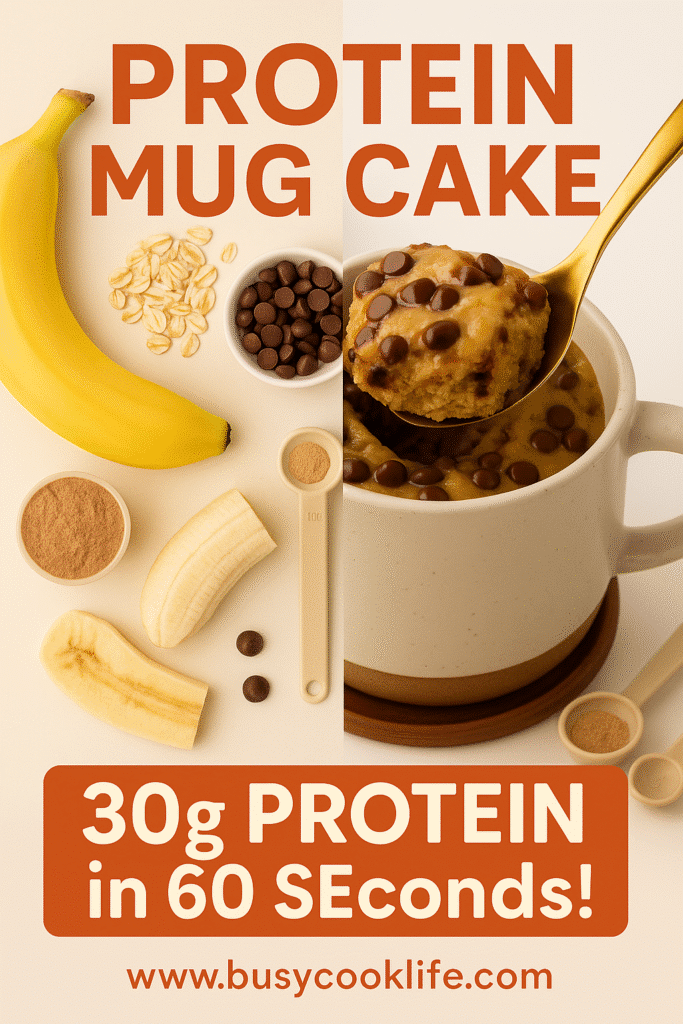
Save this protein mug cake recipe for quick high-protein desserts
Connect with us for more quick mug recipes on Facebook and Pinterest, where we share simple, fast recipes and flavor ideas for busy home cooks.
Print
The Ultimate Protein Mug Cake Guide: 30+ Grams of Protein in 60 Seconds
- Prep Time: 2
- Cook Time: 1
- Total Time: 3
- Yield: 1 1x
- Category: Dessert
- Method: Microwave
- Cuisine: American
Description
This protein-packed mug cake delivers 30+ grams of protein in just 60 seconds of microwave cooking. Perfect for busy schedules, post-workout treats, or guilt-free dessert cravings. Rich, chocolatey, and incredibly satisfying!
Ingredients
1 scoop protein powder (about 1/4 cup) 1 tbsp cocoa powder 1/4 cup milk of choice
Instructions
Mix together protein powder and cocoa powder. Add the milk and mix again. Pour into a lightly greased 8oz ramekin or mug. Microwave for 45sec – 1 min. (If baking in the oven, bake at 350F for 12-15min.) Let it cool slightly and add a drizzle of peanut butter or any toppings. Enjoy!
Notes
For extra moisture, add 1 tablespoon Greek yogurt or mashed banana. Adjust liquid based on your protein powder’s absorption rate. Microwave timing may vary – start with 45 seconds and add time as needed.
Nutrition
- Serving Size: 1 mug cake
- Calories: 220
- Sugar: 3g
- Sodium: 45mg
- Fat: 3g
- Saturated Fat: 1g
- Unsaturated Fat: 2g
- Trans Fat: 0g
- Carbohydrates: 8g
- Fiber: 3g
- Protein: 30g
- Cholesterol: 15mg

